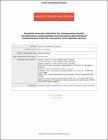| dc.contributor.author | JACKSON, ANDREW | en |
| dc.contributor.author | CROWLEY, QUENTIN | en |
| dc.date.accessioned | 2015-02-11T12:26:33Z | |
| dc.date.available | 2015-02-11T12:26:33Z | |
| dc.date.issued | 2014 | en |
| dc.date.submitted | 2014 | en |
| dc.identifier.citation | Mouchi, V., Crowley, Q.G., Jackson, A.L., McDermott, F., Monteys, X., de Rafélis, M., Luis Rueda, J. Lartaud, F., Potential seasonal calibration for palaeoenvironmental reconstruction using skeletal microstructures and strontium measurements from the cold-water coral Lophelia pertusa, Journal of Quaternary Science, 29, 8, 2014, 803-814 | en |
| dc.identifier.other | Y | en |
| dc.identifier.uri | http://hdl.handle.net/2262/73186 | |
| dc.description | PUBLISHED | en |
| dc.description.abstract | Lophelia pertusa is a colonial cold-water coral species with a wide spatial distribution in recent marine waters. Analysing the chemistry of its skeleton allows reconstruction of environmental parameter variations. While numerous studies have attempted to interpret such analyses, little information is available on the microstructures of Lophelia pertusa and their temporal constraints. This study introduces newly recognized microstructures in the coral wall following growth along the radial axis. The thicknesses of these ‘micro-layers’ are correlated with strontium concentrations and can be used to estimate seasonal growth rates of single polyps from the colony. We propose that each of these micro-layers represents a period of 1 month of mineralization and can locate two decreasing periods in growth rate during a year: one caused by limited food availability during winter months and one in autumn linked to gametogenesis. High-frequency study of strontium concentrations using this interpretation shows a lunar cycle. We demonstrate that while the micro-layers are present in all L. pertusa specimens from four locations in the Atlantic Ocean and the Mediterranean Sea, growth patterns reveal a complex organization that limits their visibility. Strontium fluctuations, however, appear to be a promising mechanism by which to establish a temporal calibration. | en |
| dc.format.extent | 803-814 | en |
| dc.language.iso | en | en |
| dc.relation.ispartofseries | Journal of Quaternary Science | en |
| dc.relation.ispartofseries | 29 | en |
| dc.relation.ispartofseries | 8 | en |
| dc.rights | Y | en |
| dc.subject | strontium | en |
| dc.subject | microstructure | en |
| dc.subject | Lophelia pertusa | en |
| dc.subject | growth rate | en |
| dc.subject | cold-water corals | en |
| dc.title | Potential seasonal calibration for palaeoenvironmental reconstruction using skeletal microstructures and strontium measurements from the cold-water coral Lophelia pertusa | en |
| dc.type | Journal Article | en |
| dc.type.supercollection | scholarly_publications | en |
| dc.type.supercollection | refereed_publications | en |
| dc.identifier.peoplefinderurl | http://people.tcd.ie/jacksoan | en |
| dc.identifier.peoplefinderurl | http://people.tcd.ie/crowleyq | en |
| dc.identifier.rssinternalid | 97304 | en |
| dc.identifier.doi | http://dx.doi.org/10.1002/jqs.2750 | en |
| dc.rights.ecaccessrights | openAccess | |
| dc.subject.TCDTheme | Smart & Sustainable Planet | en |
| dc.subject.TCDTag | Biodiversity and Conservation | en |
| dc.subject.TCDTag | Earth Sciences for Climate Research | en |
| dc.subject.TCDTag | Environmental Impacts, Interactions | en |
| dc.contributor.sponsor | Higher Education Authority (HEA) PRTLI-5 postgraduate award | en |




